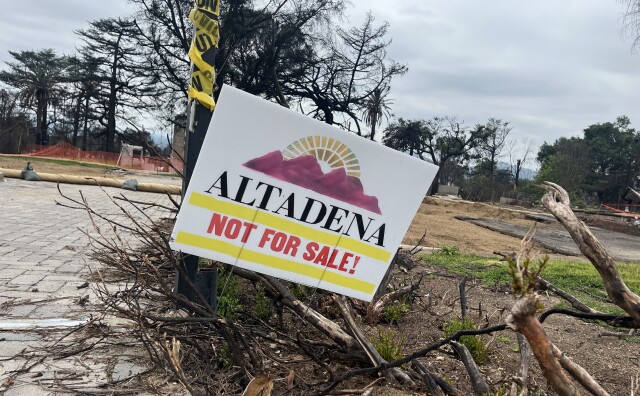Congress has cut federal funding for public media — a $3.4 million loss for LAist. We count on readers like you to protect our nonprofit newsroom. Become a monthly member and sustain local journalism.
Weekend Brings New Rains And Worries About Flooding, Mudslides And Driving Conditions

While this weekend's rainfall will be less intense than other recent storms, officials are still cautioning everyone to be careful on the roads and aware of conditions — particular in area vulnerable to mudslides.
Keep in mind that state officials said about half of the 19 people killed in storm-related incidents in that last two weeks were in cars.
Flood advisories were issued for a number of Southern California counties Saturday, as well as cautions about high seas and rip tides through earlier next week.
That said, National Weather Service meteorologists said they do not expect the issues to be as extensive as earlier in the week.
State water agency officials say this is the eighth in a series of nine storms that have hit California in recent weeks.
The Current Forecast
The first of two storms will last until about 10 p.m. Saturday, tapering off by midnight. Around an inch is expected in most of Los Angeles County but the foothills and mountains could get up to three inches.
David Sweet, a meteorologist with the National Weather Service, says with this storm, flooding and debris flow aren't of much concern like they were with the storm earlier in the week.
"Looks like the peak one hour rates are anywhere from two-tenths to three-tenths of rain," Sweet said. "And those rainfall rates usually do not cause problems."
After Saturday tonight, we'll get a break from the rain before a second storm comes late Sunday and will continue through at least Monday evening.
Radar loop at 842 AM:
— NWS Los Angeles (@NWSLosAngeles) January 14, 2023
Light to locally moderate rain continuing to move across #SoCal.
Rain rates generally 0.25"/hour or less for the area with local rates of up to 0.40"hour across #SanLuisObispo county.
Rain will continue thru the day. Be prepared for slick roads. #CAwx pic.twitter.com/rsGuJMmDnC
What You Should Know
- Expect possible flooding on the freeways
- Be prepared for rock slides in vulnerable areas, including Laurel Canyon, Pacific Coast Highway, Kanan Road, and Las Virgenes Road
Michael Anderson, state climatologist for the Department of Water Resources, says the continued rains will test the state's storm systems.
"Rivers continue to fluctuate with each storm, but they will remain high even after the rain ends. And this tends to put a strain on the levee systems and other flood management infrastructure. So just be aware that conditions hydrologically can extend even beyond the weather conditions that have been going on."
Most of the flood danger is in the Central Valley and Northern California. State officials say flood fight supplies including sand bags, levee protection, and containers have been deployed to Southern California, too.
-
Here's what you need to know when storms hit Southern California:
-
- Tips To Stay Prepared For The Next LA Storm
- Mudslides Can Be Dangerous And Destructive. This Is How You Can Prepare
- Storms Can Bring Lots Of Water — But Much Of It Winds Up In The Ocean
- Your Guide To Driving Safely In The Rain In LA (And Really Anywhere)
- How LA County Prepares For Massive Rainfall — Like The Storm Hitting Us Now
- Flash Flood Warnings? Watches? Here’s What You Need To Know
- Why Atmospheric Rivers Can Be A Blessing And A Curse
A Note To Drivers On Our Roads
This is your reminder to never attempt to drive through flooded roads. It takes just 12 inches of rushing water to carry away a small car and 2 feet to carry away most vehicles. Turn around, don't drown. #LARain pic.twitter.com/gaVMqDfUnv
— Los Angeles County (@CountyofLA) January 9, 2023
- Check your car
- Know that middays can be the most dangerous
- Plan ahead
- Turn on your headlights
- Slow down!
- If you do end up skidding, don't panic
- Don't drive through standing water
- Pay attention, duh
We have more detailed guidance: Your Guide To Driving Safely In The Rain In LA (And Really Anywhere).
Road Closures And Conditions
Check conditions before taking your trip:
- CHP current conditions (lookup by freeway)
- SigAlert (live traffic alerts)
Impact On The Drought
With the storms this month, it may be tempting to think our prolonged drought is over — but experts caution it will take more than a few exceptional storms.
Here's what we do know: The city of Los Angeles County reported Friday that it's captured more than 10.6 billion gallons of water this storm season, which is enough to support 139,00 households for a year. Or, if you want visualize it "equivalent to filling 16,000 Olympic-size swimming pools."
Still, most rainwater is lost to the ocean. The recent storms have underscored the need to accelerate the region's ability to capture more of it.
“Given the magnitude of Los Angeles' water crisis, we must urgently act to capture rainfall and keep it from being washed away into the ocean,” said Mayor Karen Bass. in statement. “I have set a goal to maximize on-site rainwater capture because that is the only way to sustain our city in the future, and I will continue to support LADWP's efforts to repair and build our infrastructure to achieve it.”
Currently, stormwater accounts for about one-third of L.A.'s water supply during a year.
California's Storm Response
There are federal, state and local emergency declarations in place.
A federal disaster declaration unlocks potential financial help for homeowners, renters and small businesses affected by the storms.
That means people should document any damages and report them to their county office of Emergency Management.
Gov. Gavin Newsom's has also announced $202 million from the state's budget will be invested into long-term flood prevention to improve urban flooding and levees, particularly in the Delta region.
About Atmospheric Rivers
A single atmospheric river can carry more water than the Mississippi River at its mouth and its winds can be dangerous.

But these phenomena are also a normal part of West Coast weather, bringing sorely needed rain and adding to the snowpack that's a key source of our state's water.
At the same time, it's the same weather event that triggered the catastrophic Montecito mudslide in early 2018.
Eric Boldt, with the National Weather Service, told us that you can think of atmospheric rivers just like the name implies: a river in the sky.
"So an atmospheric river is basically the fuel of a storm system over the Pacific Ocean," he said. "It really taps into a lot of water vapor that is streaming over the top of our heads and fueling the storm system as it moves to California."
How We're Covering These Storns
Producers from our newsroom are monitoring updates as the storm moves through Southern California. Reporting by Julia Paskin, Jill Replogle and Caitlin Hernández contributed to this story.
What Questions We're Asking
- What damage will this storm cause?
- How much rain will we get?
- Where will we see flooding?
Learn more
- Tips To Stay Prepared For The Next LA Storm
- How LA County Prepares For Massive Rainfall
- California’s Native Plants Help Hold Up Our Hillsides — But Poachers Threaten Popular Succulents
- Your Los Angeles Storm Questions, Answered
Your Questions Or Ideas
As Editor-in-Chief of our newsroom, I’m extremely proud of the work our top-notch journalists are doing here at LAist. We’re doing more hard-hitting watchdog journalism than ever before — powerful reporting on the economy, elections, climate and the homelessness crisis that is making a difference in your lives. At the same time, it’s never been more difficult to maintain a paywall-free, independent news source that informs, inspires, and engages everyone.
Simply put, we cannot do this essential work without your help. Federal funding for public media has been clawed back by Congress and that means LAist has lost $3.4 million in federal funding over the next two years. So we’re asking for your help. LAist has been there for you and we’re asking you to be here for us.
We rely on donations from readers like you to stay independent, which keeps our nonprofit newsroom strong and accountable to you.
No matter where you stand on the political spectrum, press freedom is at the core of keeping our nation free and fair. And as the landscape of free press changes, LAist will remain a voice you know and trust, but the amount of reader support we receive will help determine how strong of a newsroom we are going forward to cover the important news from our community.
Please take action today to support your trusted source for local news with a donation that makes sense for your budget.
Thank you for your generous support and believing in independent news.

-
People moving to Los Angeles are regularly baffled by the region’s refrigerator-less apartments. They’ll soon be a thing of the past.
-
Experts say students shouldn't readily forgo federal aid. But a California-only program may be a good alternative in some cases.
-
The program is for customers in communities that may not be able to afford turf removal or water-saving upgrades.
-
More than half of sales through September have been to corporate developers. Grassroots community efforts continue to work to combat the trend.
-
The bill would increase penalties for metal recyclers who possess or purchase metal used in public infrastructure.
-
The new ordinance applies to certain grocers operating in the city and has led to some self-checkout lanes to shutter.







